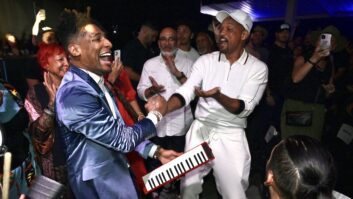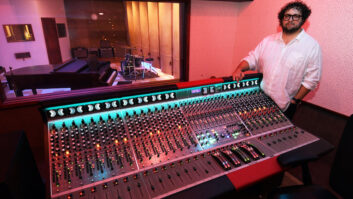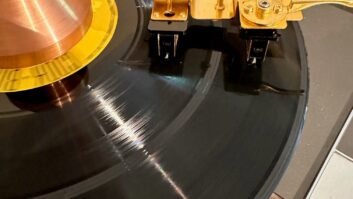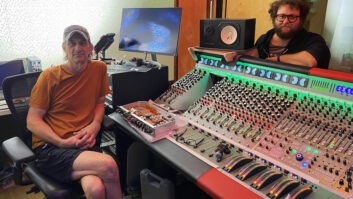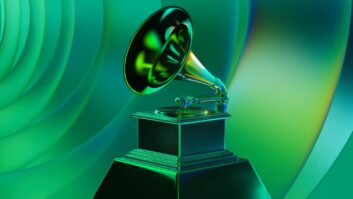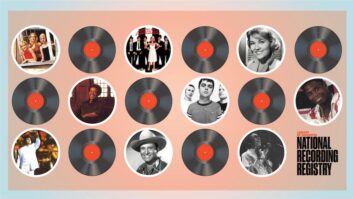The Jazz Passengers (L-R): Deborah Harry, vocals; Bill Ware, vibes; Roy Nathanson, saxophone; Brad Jones, upright bass; Curtis Fowlkes, trombone; E.J. Rodriguez, drums; and Rob Thomas, violin
Photo: Steve Jennings
THE JAZZ PASSENGERS AND DEBORAH HARRY GET “INDIVIDUALLY
TWISTED”
Writing about music is like dancing about architecture. I don’t
know who said that originally, but those are the words that come to
mind when trying to describe the Jazz Passengers. How can you
pigeonhole a group that combines lounge-y vibraphone, a moody, low sax,
a violin as part of the horn section, Dixieland trombone playing, and
then rearranges everything so the vibes are where you expect the sax to
be, the trombone becomes as soft and cool as Chet Baker’s
trumpet, and the sax delivers a hilarious, theatrical punch line?
How can you pigeonhole a jazz combo, anyway, if the sultry and
larger-than-life Deborah Harry is the lead singer? But why bother? The
Jazz Passengers know what they’re about; they play avant-garde
jazz music that at once pays tribute to and deconstructs different jazz
forms, from New Orleans-style to big band to bebop to lounge, never
losing the melody, and never losing their sense of humor. And
there’s no better introduction to the Jazz Passengers than their
latest album, Individually Twisted, on 32 Records. This record really
shows what the band can do, but it’s a little more accessible
than their previous recordings, in part because of the album’s
producers.
“When you have a band that wants to reach a wider
audience,” explains album co-producer Adam Dorn, “and they
have a piece that’s 28 minutes long called ‘Nazi
Samba…’ I mean, I love these guys, and that song happens to
be brilliant, but you’re going to limit yourself to the same
1,500 people who bought your records over and over if you keep it way
avant-garde all the time.”
Jazz Passengers engineer Joe Ferla (left) and co-producer Adam Dorn
Photo: Tiffany R. Yost
“This record is everything in terms of what the band is and
does,” adds the other co-producer (and Adam Dorn’s father),
Joel Dorn. “We didn’t change anything, we reined it in just
a little. I always try to work with people who already have something
and then work with what they have to make a record that’s more
focused, that heightens what they do.”
Joel Dorn, who has certainly worked with plenty of artists who
“have something” (Leon Redbone, Roberta Flack, Les McCann,
etc.), first became acquainted with the Jazz Passengers at the request
of the band’s manager, George Gilbert. “I went down to see
them at The Knitting Factory, and in 30 seconds I knew I wanted to
produce them. I called Adam and said, ‘Next time they appear,
you’ve got to go see them,’ and he felt the same
way.”
Adam Dorn is a bass player and keyboard programmer who has worked on
Marcus Miller-produced records for Luther Vandross, and a variety of
international artists. “There’s a certain craziness about
the band that’s just a turn-on,” he says. “We just
looked at each other and said, ‘We love this.’”
Photo: Steve Jennings
For Adam Dorn, it was gig number one as a producer, and so it was
the father and son team’s first co-production. They worked with
veteran Jazz and rock engineer Joe Ferla in Sonalyst Studios,
Connecticut, which is one of Ferla’s two favorite facilities.
“Sonalyst is an exact replica of Power Station Studio A [now
Avatar Studios], except, instead of the vintage Neve board that the
Power Station had in the city, they put in a Neve VR,” says
Ferla.
“The main room has a vaulted 35-foot ceiling, and there are
isolation rooms. I don’t want to call them booths, because they
are actually large rooms with a sound, and one of them has a little
cathedral ceiling. And then there’s a vocal booth on the side and
another booth behind. There are sliding glass doors between each space,
so that you can enclose each room. I’m not going to tell you that
there’s 100 percent isolation, but it’s pretty good.
You’ll have the isolation in the mix to be able to EQ an
instrument without affecting the sound of another.”
The layout at Sonalyst helped Ferla immeasurably with the Jazz
Passengers. “I really utilized all of those rooms,” he
says. “I had the drums [E.J. Rodriguez] in one of the rooms in
the back, totally isolated. In another room, in the back, I had the
vibes [Bill Ware] and the upright bass [Brad Jones], and I had them
baffled off from each other. In the main room, I had trombone [Curtis
Fowlkes], saxophone [Roy Nathanson] and violin [Rob Thomas]. And Debbie
was in the vocal booth. So this was a live recording, but everybody was
separate except for the horn section—the violin being part of the
horn section.”
Ferla says that one of the challenges this band poses is how to
capture the vibraphone, which is a big part of the Jazz
Passengers’ sound. “It doesn’t particularly cut
through loud horns,” he explains. “It’s difficult to
record. So we used two mics, but we also had a DI setup going through a
stereo Jazz Chorus amplifier, which was miked in stereo with two 414s
and had an AMS digital delay for chorusing. So the directs, the mics,
the mics on the amplifier and the chorusing were all combined to two
tracks in stereo, and I was able, with the mixture, to get the solid,
centered pitch of the instrument.
“The other big challenge was the violin,” Ferla
continues. “The violin acts as part of the horn section, but a
violin is not anywhere near as loud as a trombone or a saxophone. Rob
had a small amplifier that he likes to use, so we miked that amp and
had the amp behind him—as if he were onstage—so that he
could hear and be of equal volume to the sax and the trombone in the
room. There was also a direct taken, and there was a microphone on the
instrument so I could get some acoustic sound out of it.” The
instrument mic Ferla used was a Beyer M88. “It’s not a mic
that I would put on a violin in a string section or in a solo
situation,” Ferla says, “but I needed isolation, so I had
to use a hypercardioid mic. It’s a very directional microphone,
so I could get some of that bow sound, some of the rosin, some of the
tone from the wood.”
Roy Nathanson’s exciting sax playing also required an unusual
setup. “He moves around a lot, so one microphone was not covering
him,” Ferla recalls. “I put a pair of U47s on him—one
pointing up and one pointing down—so that as he tipped back and
the bell went up, the higher mic got it, and as he bent forward the
lower mic got him. I don’t believe I’ve ever had to do this
for anyone else, but I didn’t want him to feel intimidated by the
recording process; I wanted him to feel like he could just play and not
think about the microphone.”
For Deborah Harry’s voice, Ferla used an AKG C-12 mic.
“It’s a great vintage tube mic that sounded nice and rich
on her,” he says. “I like to do it with the
microphone—choose the mic and place it, and if the sound
isn’t right, change the position of the mic or replace it.
That’s what I’ll always do before I put an equalizer on. I
try to go for a big sound, a lushness and warmth and natural timbre to
the sound of each instrument.”
The one part of the production that Ferla did not record was vocals
on two songs that feature Elvis Costello. He sings one of his own
compositions, the swinging “Aubergine,” and a comic, sexy
duet with Deborah Harry called “Doncha Go Way Mad.” Those
vocals were recorded later at Electric Lady Studios by engineer Jay
Militscher when Costello was in New York while on tour with The
Attractions. (Ferla was in New York, but busy in another room at
Electric Lady recording David Sanborn.)
“This is an absolute credit to [Costello’s] work ethic,
professionalism and brilliance as an artist,” Joel Dorn says.
“We did his vocal on ‘Aubergine’ and the duet with
Debbie in maybe three hours. That was all the time he had. The one day
he was supposed to have off he’d ended up doing a special for
VH1. He was exhausted from the tour, exhausted from a 15-hour taping,
and he was a little rough at first, but then he just knocked it out.
Boy, is he a pro.”
“He’s also the only human I’ve ever seen short out
an 87 with his spit,” laughs Adam Dorn. “He warned us. He
has a gap in his teeth, and he said, ‘You know, I’ve got
this problem,’ and I said, ‘Yeah, yeah, yeah,’ and
the next thing, eeeerhh.”
“It was great working with him and Debbie,” Joel Dorn
says. “The whole thing was just fun. Years ago, when I would
record friends like Roland Kirk or Les McCann or Fathead [Newman], the
dates were always fun. But that time’s kind of been over for me
because I’ve been doing mostly boxed sets and reissues. This
reminded me of when I was really in the middle of it in the ’60s
and ’70s, when I was producing 20 or 25 albums a year. And I hope
people get the feeling off this record that the musicians put into it.
It’s one of those records that’s different but pleasant;
it’s different in an appealing way. These people have such a
command of what they do, and if that comes across, we’re
happy.”
Katherine Whalen of Squirrel Nut Zippers
Photo: Roger Marley
SQUIRREL NUT ZIPPERS: CRAZY NAME, HOT JAZZ
Long before it became serious, cerebral music enjoyed by cool customers
in smoke-filled coffeehouses, jazz was something you could kick up your
heels, dance and get down and dirty to.
Its roots were in New Orleans, where Dixieland and ragtime were
pounded out of clubs and brothels. Squirrel Nut Zippers, a Mammoth
Records band out of North Carolina, embrace this element of jazz, as
well as other early forms of the genre, with both playfulness and
passionate commitment. Their second album, Hot, has not only won over
fans of old-style jazz, but has become a left-of-center hit with
college and alternative music listeners. The Zippers played for
President Clinton’s inauguration (the 21st Century Ball, and they
headlined MTV’s Rock the Vote inauguration party) and also
performed at the Summer Olympics, as well as landing repeat
performances on NPR’s Morning Edition and Prairie Home
Companion.
Appropriately enough, the group cut its sophomore CD in the cradle
of jazz, New Orleans, at Kingsway Recording Studio. Mike Napolitano
worked as the primary engineer, with additional help from Brian
Paulsen.
Tom Maxwell of Squirrel Nut Zippers
Photo: Roger Marley
“Kingsway is a world unto itself,” Napolitano says,
“and a really great place to work. There are no clocks anywhere,
or phones and TVs everywhere. All that is cut to a bare minimum. You
don’t know what day it is, or if it’s day or night.
There’s nothing to focus on other than creating. It’s so
conducive to doing that, too. There are so many instruments laying
around that are inspiring.
“We had to choreograph the recording of each song to get a
balance,” Napolitano continues. “Tracks like, ‘Put a
Lid On It,’ were basically one microphone for the whole band, and
two mics for the drum set. Obviously, since there was one microphone
controlling the whole band, we would do takes where we would practice
the movement of individuals toward or away from the microphone, to
correctly get their levels. If there was a part where the acoustic
guitar got a little louder, we would build up steps of phone books, so
he could walk up and get the sound hole higher toward the microphone.
It was crazy, but once we got everybody’s moves down, that would
be the take that would get on the record.
“For almost everything, we used two Sony C-37s on the drums,
in an X/Y pattern out front, about six to 10 feet away. The bass was
sequestered away as much as possible with baffles. I generally used a
[Neumann] 47 to capture the vocal and remaining bandmembers’
performance. Toward the end of the project, extra mics were placed in
front of things, like a safety back-up, but they never got used during
mix.
“At the most, we used eight mics at any single time. Some
songs had an overdub or two. So whenever I miked anything for an
overdub, I used two mics to simulate the fact that they played live.
There would be one close mic, and one distant mic, to emulate the
effect created by the original three mics.
“We used a bunch of different mic pre’s, including some
that were in the board, and basically we just went from microphone to
mic pre through a compressor and straight into the tape machine.
There’s obviously no subbing of channels or anything like that,
since some of the songs only used three mics.
“The Squirrel Nut Zippers all have such a wonderful
chemistry,” Napolitano adds. “No two people have the same
job. And everybody sort of covers a different musical area. They are
amazing musicians, and very creative people, whose influences are a
little older than most. Jazz conjures up such a serious tone when you
usually say it, but that is not what that music originally sounded
like. It wasn’t this ultra-serious jazz that we are so accustomed
to hearing now. The original jazz was wild, crazy music.”
The Squirrel Nut Zippers’ Hot beautifully captures that
original jazz spirit. And as for the name, it comes from an old-time
brand of chewy peanut-flavored sweets that are still made in
Massachusetts. Now you know.
Charlie Haden Quartet West, from left: Larance Marable, drums; Charlie Haden, bass; Ernie Watts, tenor saxophone; and Alan Broadbent, piano
NOW IS THE TIME FOR CHARLIE HADEN
One of jazz’s most vital contributors is bassist and composer
Charlie Haden, a monumental talent whose emotive facility on bass
places him among greats like Charles Mingus, Ray Brown and Ron Carter.
Haden was a founding member of the groundbreaking Ornette Coleman
Quartet, and over the years, has appeared on over 400 releases.
While Haden has made his biggest mark as a jazz bassist, his range
of recording credits extends to artists like Rickie Lee Jones, James
Cotton, Ginger Baker and Beck. You could say that Haden’s musical
ecumenicalism reflects his ongoing passion for human rights issues,
which in turn has found focus in projects like the acclaimed
late-’60s ensemble, the Liberation Music Orchestra. Art and life
have been seamlessly intertwined throughout Haden’s career. One
of Haden’s most recent projects is Beyond The Missouri Sky, a
dialog between Haden and Pat Metheny that evokes the expanse of the
American Heartland. As of this writing, the album was Number One on the
Billboard jazz chart.
Ten years ago, at the urging of his wife and co-producer Ruth, Haden
formed Quartet West. The intent was to provide Haden with a hometown,
L.A.-based band when he wasn’t on the road doing other projects.
Besides Haden, the Quartet features the considerable talents of Ernie
Watts (tenor saxophone), Alan Broadbent (piano) and Larance Marable
(drums). Since its inception ten years ago, Quartet West has garnered
an amazing array of accolades, including five Grammy
nominations—two of those for the quartet’s most recent
endeavor, the evocative Now Is The Hour.
While the album offers a blend of exquisite original jazz and some
film soundtrack gems of the ’40s and ’50s, the
Quartet’s interpretive readings are very much in the present. In
addition to the Quartet’s outstanding work, Now Is The Hour also
features some fine orchestral arrangements by Alan Broadbent.
“We recorded Now Is the Hour simultaneously with a
chamber orchestra, and the entire recording took place over three
days,” says Haden. “We recorded in Paris at Studios
Guillaume Tell. All the musicians were French string players, and Jay
Newland came over to Paris to engineer the project. We had used strings
on Always Say Goodbye, which was the album before Now Is the
Hour. I really loved the way the strings sounded with the quartet,
so Ruth [Haden] and I decided, when we made Now Is the Hour,
that we would use strings for most of the record.”
Charlie and Ruth sought a sound where the strings would be more
deeply integrated into the music, rather then merely serving as
coloring. “The orchestra is woven so integrally with the quartet
that it’s almost like a fifth instrument,” Ruth Haden says.
“We discussed our desire for this orchestral effect with our
engineer, Jay, and he did a great job of capturing that.” The
album was mixed at Conway Recording in Los Angeles.
Newland, whose credits include Grammy-winning releases by Etta James
and James Cotton, as well as artists like Koko Taylor, Gatemouth Brown,
Cecil Taylor and Sun Ra, shared his insights on the making of Now Is
the Hour: “We must have had 12 channels of the main
ingredients, like Charlie, bypassing the SSL, which wouldn’t have
been my first choice of board to record this kind of music. We went
directly into the Sony 3348. I brought in some Neve and Millennia Media
preamps for the project.
“There are three elements I employ when I’m recording
Charlie. We use the RCA 44 down around the bridge, about four to six
inches away. The second mic is a [Neumann] 87 somewhere up on the top
curve of the wood, a little above the F holes. There you’re
basically getting a wood and strings sound. I place that mic six to
eight inches away from there. The third element is Charlie’s DI.
It varies from song to song. If Charlie is playing something really up
tempo, and the band is really kicking, then I might bring in more of
the DI and the 87. Like the DI, the 87 also provides some of the point
to the attack. The RCA 44 is strictly the air. That ‘air,’
or depth to the sound, is what I think he felt he wasn’t getting
before. Walter Sear [of New York’s Sear Sound] is the guy who
turned me on to using the ribbon mics on the bass. The ribbons are so
responsive to the string transients. The 44 clicks really well with
Charlie. He would say, ‘I’ve never had my bass sound like
this. Finally, someone has gotten my bass sound.’
“Charlie always needs to be in a booth, no matter what because
his ears are extremely sensitive. We put the drums in another booth
that had a kind of alcove in it, which was kind of dead-sounding.
Ernie, our tenor sax player, was placed right next to the drums. Then
the piano and the 30 strings were in the main room together.
“For the strings, I would put the warmest sounding condenser
mic over groups of four strings, maybe ten feet up. I used a bunch of
Neumanns—87s and some 67s. I had some Sennheiser MKH-40s and 20s,
which are really nice mics, especially for strings. With the cellos, we
were basically putting two on one mic, like a FET-47.
“It was really great to hear Charlie in this context. To hear
him play certain melodies, the way he goes up the neck of the bass with
this group of string players is amazing. As a producer, Ruth has got a
very good sense of what is happening, and how Charlie fits into that
picture. She hears what is going on, and if it doesn’t feel right
to her, then maybe we should try one more take. She keeps everyone from
getting too analytical or technical. After all, this is supposed to be
about feeling.”
We’ll give the last word to Charlie Haden: “Each
musician in the Quartet is a great improviser, and really places
importance on improvisation and playing music that has never been
played before. I always seek out musicians that feel that same way
about music as I do. Ornette and I used to talk about playing music
like you had never heard it before, and you’re playing it for the
first time. I think all of the musicians that make an impact on the art
form approach music by trying to create something that has never been
before. That is the way the guys in the Quartet approach
music.”
From left: Dave Samuels, marimba and vibes; Paquito D’Rivera, saxophones, clarinet; and Andy Narell, steel pans
BACK TO THE CARIBBEAN WITH ANDY NARELL
The Caribbean Jazz Project, formed in 1993, is the combined vision of
three unique and familiar jazz talents: Paquito D’Rivera (sax,
clarinet), Andy Narell (steel pans) and Dave Samuels (marimba and
vibes). The seven-piece ensemble, which also features Dario Eskenazi
(piano), Oscar Stagnato (bass), Mark Walker (drums) and Pernell
Saturnino (congas and percussion), delivers a spirited fusion of Latin
American grooves and jazz.
All three of the principals have long and impressive credentials:
D’Rivera has played with McCoy Tyner, Dizzy Gillespie, Toots
Thielmans, Lalo Schiffrin, Stanley Turrentine, Lionel Hampton, Tito
Puente, Carmen McRae among many others, as well as performing with the
London Philharmonic and the Cuban National Symphony Orchestra. Samuels
was a founding member of Spyro Gyra and has also appeared on records by
Chet Baker, Stan Getz, Frank Zappa, Bruce Hornsby and Pink Floyd. Andy
Narell’s amazing command of the steel drums has been amply
demonstrated on six albums he has made for the Windham Hill label, all
of them worth checking out.
The Caribbean Jazz Project has recorded two albums for the Heads Up
Entertainment label, the most recent being Island Stories. Narell, who
co-produced the album with D’Rivera and Samuels, shared some
details about the dynamics of recording an ensemble that is so rich in
percussive elements.
“We rehearsed the music a few days and then did a six-night
run in New York at the Blue Note,” Narell says. “We then
went directly to the studio and did the album in about three days at
Jay Beckenstein’s studio, called Beartracks, in Suffern, New
York. It’s a beautiful studio in an old stone house, and a lot of
people record there.
“There’s one large main room with very high ceilings,
where we put the piano and blanketed it in. I was out there wide open
in the room, too. The electric bass was run direct. For Paquito’s
horns, we built a little ‘house’ in the studio, with real
tall gobos and one that comes down from the ceiling that created a
roof. We put Dave Samuels in the iso room, next to the control room,
and placed the drums in a space above the control room. There was a lot
of eye contact.
“Recording Dave Samuels’ marimbas and vibes is real
critical,” Narell continues. “Dave uses this huge concert
Rosewood marimba. You practically have to walk from one end to the
other, just to play it. To get a really nice sound that captures
what’s going on in the room, and to get a nice stereo image, I
found that the smaller diaphragm mics have what I’m looking for,
like the Schoeps, B&Ks and the KM84s. I have my own pair of KM64s
for my pans [steel drums]. It’s a modified KM54 mic, with the
same tube, but the capsule is like that of a KM84, and it has a pad.
After some research, I realized that was the mic that sounded best on
my instruments.
“Steel pans are like an orchestral thing where you have
different ranges, just like with strings—violin, viola, cello. My
normal setup is to have three pans on the gig, which would be one solo
soprano instrument, and a double alto sax range instrument, which is
called the double second. This time out, I had larger than my usual
setup, with two more drums that gave me more low end extending down
into the baritone range.
“For the double second, I used the KM64s. I used a 451 on the
soprano, and we put a pair of KM84s on the lower two pans. When I
played the soprano instrument, which used the 451, I found that I liked
the sound much better if I left the other mics on. The room sound I was
getting off of those KM64s was so beautiful that it just warmed up
everything.
“We used a 251 on Paquito’s clarinet, and a TLM-170 on
his alto sax. I like the sound of a little compression on the bass
going to tape, so we used a [UREI] 1176 for the bass. On everything
else, I felt that we could wait and use the digital compressors, which
worked just fine. The digital compressors sounded really great on
marimba, vibes and horns. We tended to stay away from it on piano and
drums. We might have touched it a little on the steel pans and
congas.
“These instruments are a pain in the butt to record,”
Narell says with a laugh. “It’s a real fine line between
trying to get control of the sound and over-compressing, or just
letting it all go and having all kinds of balance and level problems
that may cause you to drop the whole level of the recording, because
you can’t get an instrument under control, because it has such
dynamics. So a lot of the time, I would compress a little bit less, and
spend the time riding tracks, to keep the things together.
“Basically, this was seven people playing live, which was the
concept of this record. There are very few overdubs or fixes on this
record. Doug Oberkircher engineered the tracks. The whole project went
down really smoothly. Dave and Paquito came out here to help with the
mixes out at my place, which was tuned by Bob Hodas. I mixed through my
Genelec 1031s. I have a Yamaha 02R console, which has really powerful
and easy-to-learn automation. I’ve also been really surprised at
how good the compressors are on the 02R. I have yet to go, ‘Boy,
I wish we had a GML or Focusrite.’ As far as I’m concerned,
there is nothing not to like about it. It sounds great.”
At Fantasy Recording Studios in Berkeley, Calif.: drummer Colin Bailey, bassist Essiet Essiet and guitarist Ron Affif
Photo: Steve Maruta
RON AFFIF LIVE AT FANTASY STUDIOS
Jazz guitarist Ron Affif has many fans. Guitar Player magazine
has raved about his “fertile melodic imagination.” The New
York Times admired his “complete command of the jazz guitar
vocabulary.” And guitar master George Benson praised
Affif’s style: “My favorite type of guitar player is one
that plays with fire, and the first thing that becomes evident
listening to Ron is that he has plenty of that.”
The 32-year old guitarist is a Pittsburgh native, but now lives in
New York City, where he and his trio play gigs at popular jazz spots
like the legendary Village Vanguard and the Zinc Bar. In 1992, Affif
was signed to Pablo Records, one of 14 label subsidiaries of Fantasy
Records, headquartered in Berkeley, California. (Pablo was originally
founded in 1970 by Norman Granz, who started Verve Records. In 1986,
the Pablo label was added to the Fantasy roster, which also includes
such well-known imprints as Original Jazz Classics, Prestige,
Riverside, Milestone and Stax Records.)
For Ringside, Affif’s fourth album on Pablo, producer Eric
Miller decided to record the trio—Affif, bassist Essiet and
drummer Colin Bailey—before a small live audience at Fantasy
Studios in Berkeley. For the sessions, Studio A was set up like a jazz
club, complete with soft lighting, candlelit table settings for 40, and
a bartender. An audience was brought in, and two 1½-hour sets were
recorded each night over three nights in February (including a special
Valentine’s Day show). There’s a bit of historic
significance in the project: The last time Studio A was used for a
live-concert jazz session was in 1973, when Cannonball Adderley
recorded the Fantasy release Inside Straight.
The sessions were recorded by engineer David Luke and assistant
engineer Richard Duarte. Affif plays a Buscarino Monarch guitar into a
Polytone Mini Brute II; he was miked with an M269 and a KM84; and four
U87s picked up the audience. For Colin Bailey’s DW drum kit,
“we had a pretty straightforward mic set-up,” Luke says.
The kick was miked with AKGs: a D-112 in front, and a 414 TLII in back;
an SM57 was used on the top of the snare; An AKG 452 was used on the
hi-hat, KM84s on toms, and overheads were KM54s with gold capsules.
Essiet used two pickups on his bass, a Barcus-Berry and a Polytone.
These were sent through Demeter tube DIs into a single Polytone Mini
Brute with a 15-inch speaker amp, miked with a U67; in addition, the
bass amp was miked with a U47; the bass sound on the album is mostly
the tube mics, with some of the DI sound blended in.
Everything was recorded on Studer A800s, “There’s a
Mitsubishi digital multitrack here, but I was perfectly happy recording
to Dolby SR,” Luke says. “We had two multitracks, each
rolling until it was two-thirds of the way through, to make sure
nothing was missed.”
Mixing took three days, and was done on an SSL 4056 E/G. As with
most jazz recordings, minimal effects processing was used, mostly
compression and reverb, plus some slight Pultec and Manley tube EQ.
Luke says that for his guitar sound, Affif “likes it to be big
and fat, and with a fair amount of reverb. Some jazz people don’t
like that much reverb, but Ron likes it.” A plate reverb effect
was added to Affif’s guitar, in combination with live chamber
reverb. (Fantasy is one of those rare facilities that still has reverb
chambers: “It’s the kind of thing where, if you don’t
have it already, you’re not going to build one,” jokes
Luke.) On drums, a combination of AMS and Lexicon 480 reverbs were
added.
Luke says recording a live concert in the studio offered the best of
both worlds: There’s the element of excitement that comes with
being involved in a live performance, as well as the comfort of having
consistency in the recording environment. “Being in the studio,
in front of a live audience is a lot better for us, because
there’s none of those unpredictables that you have when
you’re doing a real remote recording,” explains Luke, who
has been recording at Fantasy for ten years and is also a veteran of
the Bay Area remote recording scene. “All of that pressure that
you have when recording in a remote truck was gone. We were in a place
where we do most of our work, in a room I’m totally comfortable
with. I have all my favorite gear, everything I knew like the back of
my hand. I was not worried in the least.” Judging by the success
of the project, this just may be the start of a new trend of live
concert sessions at Fantasy.
32 JAZZ
32 Records, the label that released The Jazz Passengers’ latest,
recently started a new division: 32 Jazz. The new label was created to
handle an extensive series of reissues by jazz artists, past and
present. The entire series was produced by Joel Dorn and mastered by
Gene Paul at dB Plus Mastering. Many of the reissues are double-CDs
that include two albums’ work, and the liner notes include the
original information and artwork, plus recollections of the original
producers and observations by Dorn. Two of the label’s first
offerings are shown above.

